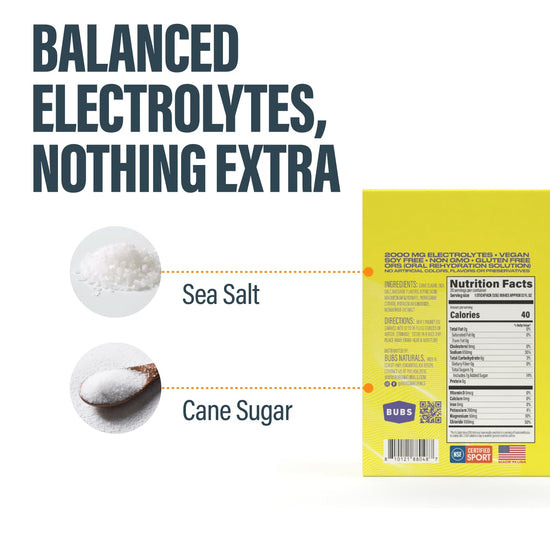Table of Contents
- Introduction
- Understanding Electrolytes and Their Importance
- The Nutritional Profile of Celtic Salt
- How Does Celtic Salt Compare to Other Sources of Electrolytes?
- Practical Applications of Celtic Salt in Your Diet
- The Implications of Using Celtic Salt for Hydration
- Conclusion
- FAQ
When it comes to enhancing our health and hydration, the conversation often turns to electrolytes. These essential minerals are pivotal for various bodily functions, and recently, Celtic salt has sparked curiosity regarding its potential electrolyte content. But does Celtic salt truly contain the electrolytes our bodies need, and can it play a role in our hydration strategy? Let's dive deep into this topic to uncover the truths about Celtic salt and its nutritional profile.
Introduction
Did you know that nearly 75% of Americans are chronically dehydrated? This startling statistic underscores the importance of understanding how we can optimize our hydration and overall health. As we explore dietary sources of electrolytes, Celtic salt has emerged as a popular topic among wellness enthusiasts, prompting the question: Does Celtic salt have electrolytes?
Celtic salt, also known as sel gris, is a type of sea salt harvested from the coastal regions of Brittany, France. Unlike regular table salt, which is heavily processed, Celtic salt retains a unique mineral profile due to its traditional harvesting methods. This has led many to believe that it offers specific health benefits, particularly regarding hydration and electrolyte balance.
In this blog post, we will investigate the composition of Celtic salt, its potential health benefits, and whether it can effectively contribute to your electrolyte intake. By the end, you’ll have a clearer understanding of how Celtic salt fits into the broader context of hydration and wellness.
We'll explore the following aspects:
- The importance of electrolytes and their role in the body.
- The nutritional profile of Celtic salt and its mineral content.
- How Celtic salt compares to other sources of electrolytes.
- Practical applications of Celtic salt in your diet.
- The implications of using Celtic salt for hydration.
Let’s embark on this journey together to discern whether Celtic salt deserves a place in your wellness routine.
Understanding Electrolytes and Their Importance
Electrolytes are minerals that carry an electric charge and play critical roles in various bodily functions. Common electrolytes include sodium, potassium, magnesium, and calcium. These minerals are vital for:
- Maintaining Hydration: Electrolytes help regulate fluid balance in the body, ensuring cells remain properly hydrated.
- Supporting Nerve Function: They facilitate the transmission of electrical signals between nerve cells, influencing everything from reflexes to muscle contractions.
- Muscle Function: Electrolytes are essential for muscle contraction and relaxation, making them crucial for physical performance.
When we sweat, we lose not only water but also essential electrolytes. This is why replenishing these minerals is critical, especially during intense exercise or in hot climates.
The Nutritional Profile of Celtic Salt
Celtic salt is unique in its composition compared to standard table salt. It is typically composed of approximately 85% sodium chloride, with the remainder consisting of various trace minerals. Here’s a breakdown of the mineral content in Celtic salt:
- Sodium: While Celtic salt contains sodium, it is less processed than table salt, which can make it a more natural option.
- Magnesium: Often cited for its muscle-relaxing properties, magnesium is present in smaller amounts in Celtic salt.
- Potassium: Important for heart health and muscle function, potassium is also found in trace amounts.
- Calcium: Essential for strong bones and teeth, calcium is present, albeit in minimal quantities.
However, it’s essential to note that the amounts of these minerals in Celtic salt are relatively small when compared to other dietary sources. For instance, while Celtic salt does contain electrolytes, the concentrations are not sufficient to rely solely on it for replenishment during hydration efforts.
How Does Celtic Salt Compare to Other Sources of Electrolytes?
When considering hydration and electrolyte balance, it's helpful to compare Celtic salt to other common sources of electrolytes:
-
Electrolyte Drinks and Powders: These products are specifically formulated to replace lost electrolytes quickly and effectively. They often contain higher concentrations of sodium, potassium, and magnesium than can be found in Celtic salt.
-
Whole Foods: Fruits and vegetables like bananas, spinach, and avocados are rich in electrolytes. For instance:
- Bananas are high in potassium.
- Spinach provides magnesium and calcium.
- Coconut water is a natural source of electrolytes and can be hydrating and refreshing.
-
Broths and Soups: Many homemade broths are naturally rich in electrolytes, particularly when made with bones, vegetables, and herbs.
While Celtic salt can enhance the flavor of food, it should not be considered a primary source of electrolytes, especially for those with active lifestyles or dehydration concerns.
Practical Applications of Celtic Salt in Your Diet
Celtic salt is versatile in the kitchen and can be used in a variety of ways to enhance your meals while contributing trace minerals:
-
Seasoning: Use Celtic salt to season meats, vegetables, and grains. Its unique texture and flavor can elevate your culinary creations.
-
Bath Soaks: Adding Celtic salt to bathwater can create a relaxing experience. Many enjoy the sensation of soaking in saltwater, which is believed to soothe sore muscles and promote relaxation.
-
Salt Scrubs: Celtic salt can be mixed with oils to create a natural exfoliating scrub, perfect for revitalizing your skin.
-
Homemade Electrolyte Drinks: You can create your own electrolyte drink by mixing Celtic salt with water, lemon juice, and a touch of honey. Though not a substitute for commercial electrolyte drinks, this can be a refreshing alternative.
The Implications of Using Celtic Salt for Hydration
While Celtic salt does contain trace minerals, relying on it for hydration or electrolyte replenishment may not be effective. Here are some important considerations:
-
Limited Mineral Content: The trace amounts of electrolytes present in Celtic salt may not be sufficient to meet the needs of someone who is highly active or experiencing dehydration.
-
Sodium Intake: As with all salts, it's important to monitor sodium intake. Excessive sodium consumption can lead to health issues such as high blood pressure.
-
Balanced Diet: For optimal hydration and health, it's best to obtain electrolytes from a diverse diet rich in fruits, vegetables, and whole foods, complemented by natural salt options like Celtic salt.
Conclusion
In summary, while Celtic salt does contain trace amounts of electrolytes, it should not be viewed as a primary source for hydration or electrolyte replenishment. The unique flavor and mineral profile of Celtic salt can certainly enhance your culinary experiences, but for effective hydration, consider incorporating a variety of fruits, vegetables, and specialized electrolyte products into your diet.
As we embrace a holistic approach to wellness, it’s crucial to understand the role of different elements like Celtic salt within the larger context of our health. By balancing our intake of electrolytes through wholesome food sources and mindful hydration strategies, we can better support our bodies in achieving optimal health.
FAQ
1. Does Celtic salt help with hydration?
Celtic salt contains trace minerals that can contribute to hydration, but it is not a sufficient source of electrolytes on its own. It's best to combine it with a balanced diet and hydration strategies.
2. How much Celtic salt should I use?
Use Celtic salt sparingly to enhance the flavor of your dishes. It’s important to monitor overall sodium intake to maintain health.
3. Can Celtic salt replace electrolyte drinks?
No, while Celtic salt can provide trace minerals, it does not contain enough electrolytes to replace specialized electrolyte drinks, especially for athletes.
4. What are good alternatives to Celtic salt for electrolytes?
Fruits, vegetables, coconut water, and homemade electrolyte drinks are excellent alternatives for maintaining electrolyte balance.
5. How does Celtic salt compare to Himalayan salt?
Both Celtic and Himalayan salts contain trace minerals, but their specific mineral profiles may vary. Generally, neither is significantly healthier than the other in terms of overall health benefits.
By understanding the nuanced roles of Celtic salt and other electrolyte sources, we can better navigate our hydration and wellness journeys. Together, let’s embrace adventure, wellness, and a purposeful approach to nutrition!
Written by:
Bubs Naturals

Hydrate or Die
When you’re sweating hard—whether it’s from a tough workout, a long day in the sun, or just life—your body needs more than water to stay balanced and energized.
Hydrate or Die® delivers 2,000 mg of electrolytes in every serving to help you rehydrate faster, fight off fatigue, and keep going strong. That includes the right mix of sodium, potassium, and magnesium to support muscle function, prevent cramps, and maintain energy levels.
With a small dose of natural cane sugar to speed up absorption, this clean, easy-to-use powder is made for real performance—not just flavor.
Starts at $27.75
Shop

